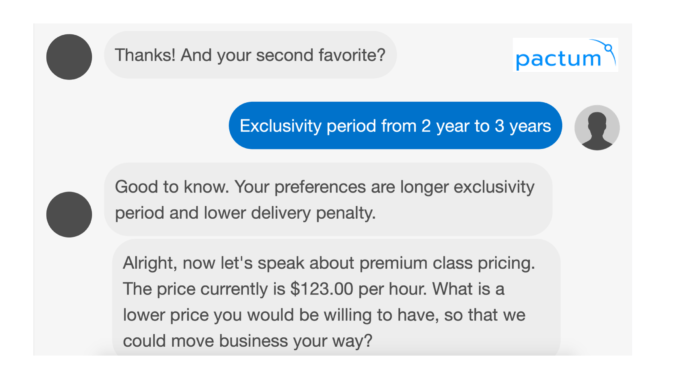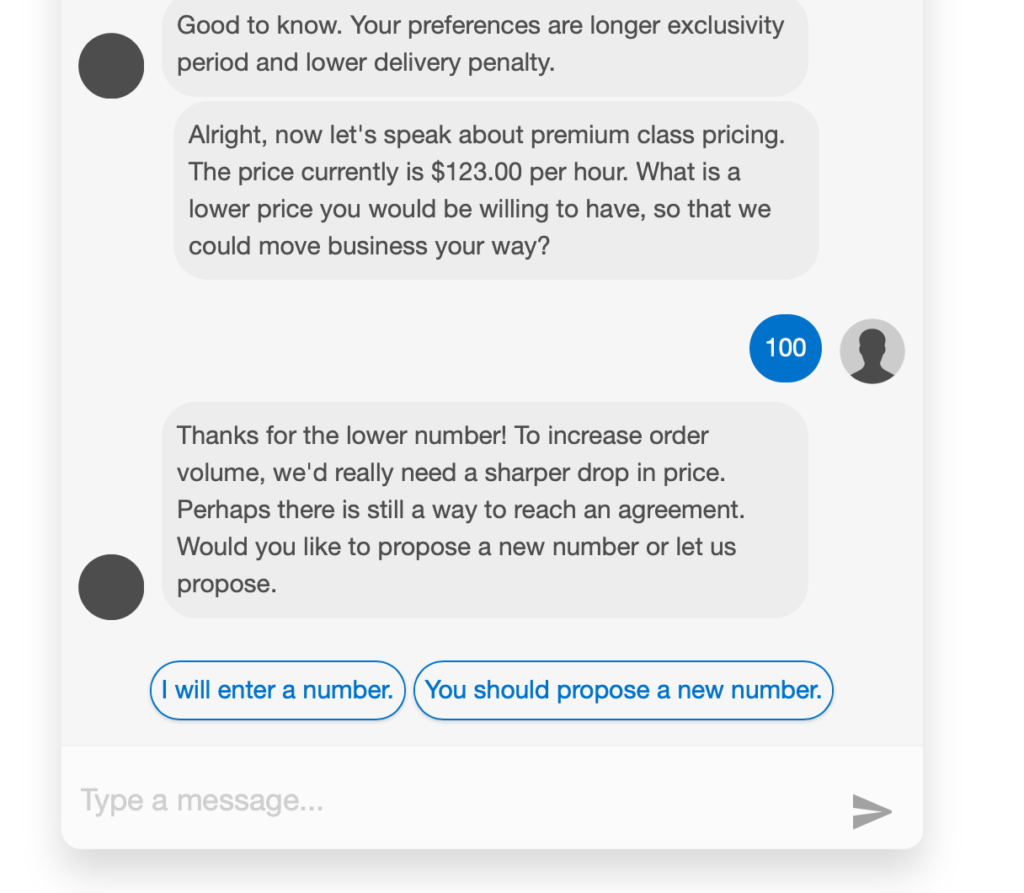
Pactum is a new AI-based Q&A platform that enables companies to automate commercial contract negotiations on ‘a massive scale’. It’s just signed up Walmart for a pilot and from first impressions it could indeed have an impact, especially in areas such as renewals and renegotiations of existing boilerplate contracts.
Put simply, what it does is take the main aspects of a contract and automatically offer them up to the counter-party for negotiation using an online Q&A dialogue box (see below). It asks you questions, proposes new terms, you can then accept or push-back and seek to drive the system to a position you want. It does this until all the key commercial terms in a contract are completed. You then get moved to esigntaure. And you’re done.
Why is this a big deal? Because it largely removes human input from the party providing the contract. For large companies, such as Walmart, which may have thousands of supplier deals, often using relatively simple boilerplate contracts that only need slight renegotiation, this is a massive efficiency gain.
It also helps to automatically create a wealth of new data about how counter-parties respond to different negotiation positions. This data is a lot easier to collect and measure because the entire negotiation is in a digital framework.
Also, it’s worth pointing out, the Q&A system allows you to escalate the contract negotiation to a human if you wish. So, you are not stuck with a ‘Computer says no’ logical cul-de-sac if things go amiss.
You could call it a bot, or a rules-based natural language platform with machine learning elements. The main point is that the party with Pactum creates an online contracting space, where there are not just empty blanks for you to fill in, there is an active ‘agent’, albeit coded into the back end of each contract that is set up for negotiation. This is coded to seek out compromise positions that will also, it appears from the demo, overall favour the party with Pactum.
Artificial Lawyer strongly recommends checking out the demo on the website, which shows a renegotiation of a supplier contract. Artificial Lawyer ran the demo a few times and it was fascinating. If you let it, the system would walk all over you, but if you pushed back really hard you ended up with some compromises.
However, the logic it uses is very clever, and the compromises include offers on other aspects of the contract that you might just agree to in order to reach a deal, though perhaps they may lock you into things you may not have thought too much about. In short, it really felt like dealing with a highly motivated person who knows how to push hard and also sweet-talk you into agreeing things. See demo on main page.

Pactum’s deal with Walmart will focus on the company’s ‘long tail vendors’ – which it defines as ‘low-value high volume’ deals. So, lawyers need not panic. What this is doing is handling work that experienced legal professionals are largely wasted on and in many cases would not be doing in the first place.
However, is this ‘legal work’? In a way, yes it is. It’s renegotiating a legally binding contract. That said, in most cases it will be a sales/accounts person who will handle such matters. And this perhaps underlines how grey the grey area is between ‘legal work’ and sales.
The company is based in California and got going late last year. It has some seed funding and much will be riding on its pilot with Walmart. Let’s see where this goes.
Martin Rand, Pactum CEO, said in a statement: ‘We’re thrilled to be working with Walmart. It’s encouraging that, as a leader in cutting edge technological innovation for efficiencies across its enterprise workflows, they see the value in what Pactum offers.’
‘The underlying principle of efficient negotiations is that it’s not a zero-sum game. The fact that one party wins with Pactum means the other party will win as well. Pactum removes the inefficiencies from low value, high volume deals,’ he added.
In addition to retail, Pactum is also helping with negotiating deals in real estate, online marketplaces, and online advertising.
—
And, if that has got your interest then read the following. It’s part of a blog post by Rand about what inspired the company’s creation.
‘Initially, we wanted to create a global sparring platform for negotiators and teach the AI based on these learnings. We took Harvard Business School negotiation simulations and asked people to negotiate. What we quickly noticed was that no matter how proficient negotiators they were, they almost never achieved Pareto optimum. There was an effect that made the situation even worse. According to the Pareto principle, 80% of commercial agreements are ‘long tail’- meaning low value, high volume. Negotiating this vast number of contracts in large corporations is almost impossible with people. Enterprises even have a name for them — the unmanaged long tail.
Achieving superhuman levels in a situation where the largest companies in the world called 80% of their contracts ‘unmanaged’ became easier than we thought. We don’t need to build a bot with general intelligence. We just need to build a system that is better than the status quo – which is people avoiding having to negotiate low-value high volume deals at any cost.
So we built a bot that can negotiate. Our system consists of two parts: the value function and the negotiation flow. The value function defines every possible variation and all dependencies between the negotiation items. The negotiation flow is a collection of recursive graphs of human-understandable negotiation strategies and tactics.
The role of AI is to learn from each negotiation and get better in the next. Mathematically the shortest way to a Pareto optimal deal is by creating value for both sides. Note that AI will learn about humans not from humans during these negotiations. The negotiation strategies and tactics are prepared by our negotiation scientists. Thus it does not perpetuate existing human biases. The task of AI is to find the best way to get to a Pareto efficient deal.’
1 Trackback / Pingback
Comments are closed.